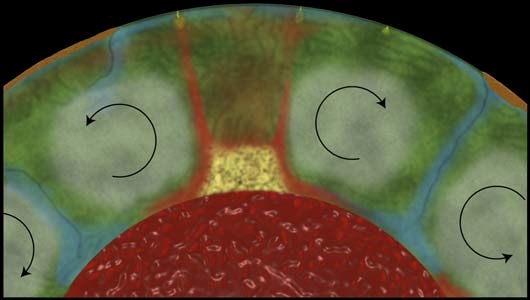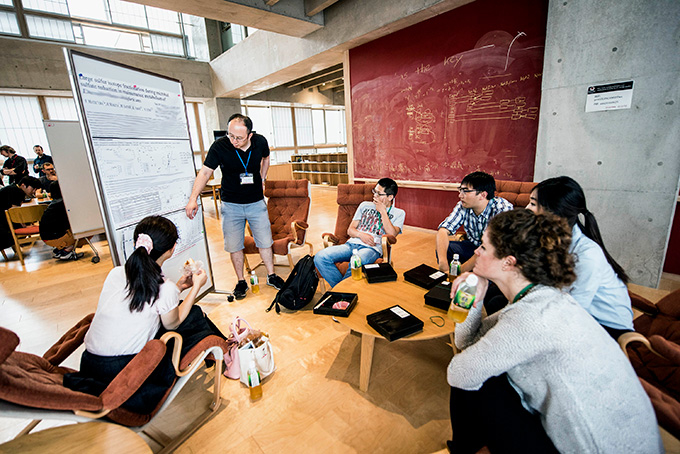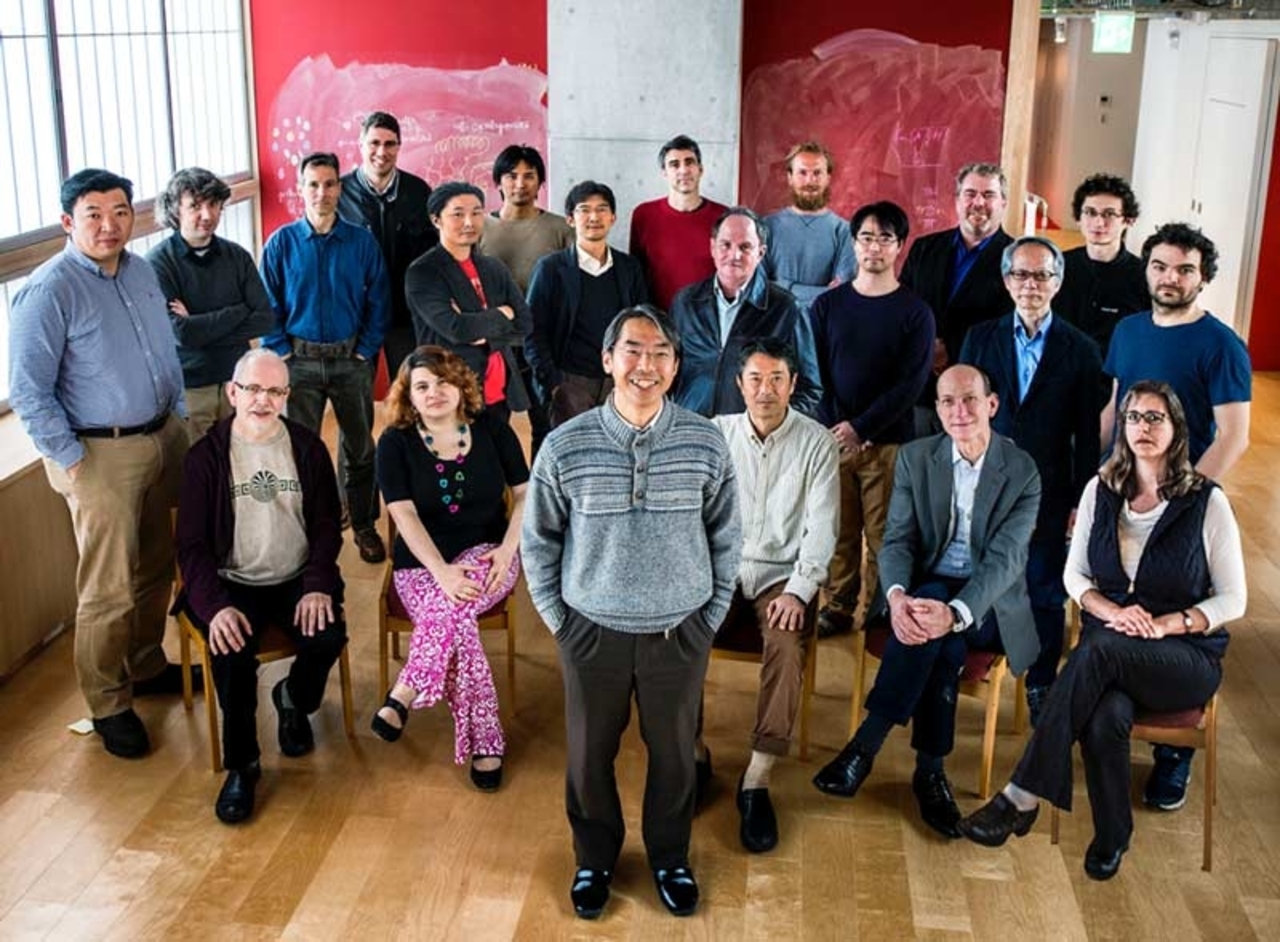
Issue 36
Professor and Vice DirectorJohn Hernlund
Earth-Life Science Institute
As Tokyo Tech's Earth-Life Science Institute (ELSI) has evolved, it has needed senior scientists to lead research in key areas, managers to help run the institute, recruiters to search out prospective researchers and students around the world, educators to serve as advisor to doctoral students, and a friend to invite its many visitors from abroad home for dinner. Almost since ELSI began, John Hernlund has been doing all this and much more. A tenured Tokyo Tech professor, he is a passionate advocate for ELSI as well as a top scientist in his deep Earth field.
Earth and life as systems
You are a geophysicist, and you model the dynamics of the interior of the Earth. What makes your science relevant to an origins of life institute like ELSI?

At ELSI we're very interested in understanding the origin of the planet and how it gave rise to life. All of our current theories, all the evidence, suggests that life started more than 3.8 billion years ago. Unfortunately, we don't have many rocks that are this old to study. So answers to lots of questions about what the early Earth was like, how was it formed, how did it give rise to the environment that created life, are buried deep inside the planet. It's like going to the Grand Canyon and seeing all the layers of the Earth as you go deeper and deeper, each one from further back in time.
Life is very old and has been evolving as a part of many systems that are all connected with each other — like plate tectonics, the composition of the atmosphere, the planet's core that makes the magnetic field. It's an open system. As living things, we eat matter which becomes incorporated in our bodies, and then we get rid of it. So we're actually not a thing, we're a process. We have to understand how the entire planet collaborates to make something like life possible and how then life evolves over time as the planet changes and how the systems interact with each other. These are the great questions of all of natural science. And we have to understand what is happening underneath our feet to be able to address all of them.
This kind of systems thinking is very important at ELSI. Why is that?
In the 20th century, science took a more focused approach and drilled very deep and also very narrow. It made many breakthroughs this way. But the big questions — like how life came to be on Earth, or is life possible elsewhere in the universe and if so, how would it happen and where should we look — these are questions you can't find the answers to by drilling deep and narrow. You have to put things together and look at the larger picture.

Life exists on Earth because of its unique environment. ELSI researchers work to (A) determine the structure of the Earth, (B) identify the kind of life that first appeared and when its birth took place, and (C) investigate how those early life forms evolved, through multiple perspectives and procedures. Then, by applying those discoveries on genetic information of primitive life forms, they aim to further explore (D) "whether life would arise in environments entirely different from Earth."
Do any of your own recent findings show these connections?
Some work that made a really big impact on ELSI involves the origin of the magnetic field in the Earth. It connects life on the surface to processes happening very deep beneath our feet in the metallic core where we think that convection currents are responsible for producing the magnetic field by dynamo action1. Heat lost from the deep interior of the planet to the surface drives convection flow and overturn of both the rocky mantle and the liquid metal core inside the Earth, much like the convection you can see in a bowl of hot miso soup as it cools down. Of course the rock moves very slowly, at speeds of roughly centimeters per year, while the liquid core currents move at about 0.1 millimeters per second. In my research I use quantitative models to study the connection between material properties at extreme conditions, heat loss from the interior, chemical cycling, and sustenance of deep magnetism.
What we've been able to do — with a collaboration of theory and experiments — is to open the question of how did the core cool down, what did the initial temperature have to be, and what was the chemical composition in order to have conditions necessary to have an ancient magnetic field. We see in biology that some very ancient forms of life used magnetism. For example, "magnetotactic" bacteria produce magnetite crystals inside themselves, which helps them orient along the magnetic lines. And in the local environment this means they could go find more or less sunlight, more or less oxygen, different nutrients. It was a very ancient form of eyesight, based on magnetism coming from the core.

Illustration of bridgmanite-enriched ancient mantle structures (BEAMS), a model proposed by Hernlund and colleagues describing how large-scale silica-enriched highly viscous regions stabilize and organize the pattern of convection in the lower mantle. (Ballmer et al. "Persistence of strong silica-enriched domains in the Earth's lower mantle." Nature Geoscience 10, no. 3 (2017): 236.)
An ELSI veteran
You were an early hire in ELSI. What interested you in coming to Japan and to the just-beginning institute?
I've been working with a lot of colleagues now at ELSI for many years. For example, Kei Hirose, the director, and I had been working on very similar topics and we had some nice results together. Hirose-san and others were trying to recruit me to come to Tokyo Tech in 2009 or 2010, but that was not a good time. So we waited until the opportunity came along, and I joined the WPI (World Premier International Research Center Initiative2) proposal as a principal investigator.
I came to Tokyo Tech for the opening ceremony of ELSI in 2013 and heard impressive speeches from officials of MEXT (the Ministry of Education, Culture, Sports, Science and Technology) and from Mishima-sensei (Yoshinao Mishima, Tokyo Tech president from 2012 to 2018).
They had a vision for how ELSI could help the university to become more sustainable and more international and more visible in the world. To work as a partner in that effort was something I strongly believed in and it drew me to Tokyo Tech. I still believe in that vision and that it's a wonderful opportunity we have here.

Hernlund in an ELSI meeting room designed in traditional Japanese decor. The space includes tatami mats and hori-gotatsu (a low table with legroom recessed into the floor).
Why do you think the Japanese government has invested so much in the WPI program that includes ELSI?
I think they're doing this because the Japanese national universities are facing a demographic implosion, with fewer and fewer Japanese graduate students.
The same thing happened in the U.S. and, if you go to top science and engineering institutions there, you'll find the students are dominantly non-American. So this is the model for how a top university survives today — they internationalize.
Tokyo Tech leadership has known about this for a long time. Hopefully they will use the lessons of ELSI — the success and the failures — to help the transformation into an international university. Our involvement in education is key to that, and I hope it continues to grow. Our exclusive use of English is also an important step forward for the university.
WPI also wanted their institutes to be multi-disciplinary. We have embraced that and created a special environment for people from very, very different fields. They come together and talk with each other and have conversations that people say could only happen at ELSI. We often hear this from colleagues who come to visit. There might be a microbiologist talking with an astrophysicist, and the kind of thoughts they come up with together can be very unique.


ELSI researchers from various disciplines holding discussions unrestricted by field
As a young person, what made you decide to go into your field of science?
I was always interested in nature and when I was young we used to hike in the mountains. My father was studying at a school for mines in the U.S., though he was in chemistry and eventually became an expert in petroleum refining technology. But they had a geological museum there, and I grew really interested at a young age about the fossils and things like that. Also, I had a great high school teacher who inspired me to study geology when I went to college.
I started off wanting to be a field geologist trotting around the world, but whenever I went someplace to do some geological mapping I wondered what was happening underneath me. Why are the rock layers tilted this way? Why is this fault here? Where did the magma come from? The answers to these questions always led to deeper in the Earth, to peeling back the layers to get at the causes. I then went into geophysics and seismology. I later started working in a high pressure laboratory doing experiments on rocks at high temperatures and pressures to simulate conditions deep inside the planet.
A field with a bright future
Is your field a promising one for students, a field with future prospects?

Absolutely. One of the new opportunities already present and growing more important is exoplanets. We're starting to see thousands of planets beyond our solar system. So far most of the interpretative work of the observation of exoplanets has been made by astronomers and so models of the planets and ideas about the planets have been poorly developed. There's going to be an increasing need for us to better characterize what these planets are like. Especially because we want to search for life, we have to focus on a specific promising planet and point the telescope there for some time.
The way to make the decision of which planet to study is to have a better understanding of how planets work in general. Modeling the connection between the dynamics and evolution of planets and their physical properties — the high pressures and temperatures, whether they have plate tectonics, what is the volcanic activity, how was the atmosphere formed — all of these things are very central to tackling that science.
Do you think scientists will ever have definite answers about how Earth went from having no life to having life?
I don't think we'll be able to say with certainty how life started on Earth. But what we will be able to do is to understand how a range of different possibilities might have happened on Earth. I think that is very valuable. Because if we understand a range of ways that life could have originated on Earth, that will help us to then translate that to other planets. The more we learn about what was needed for life to begin here, the more we'll have some general understanding of how that process should work elsewhere.
But the particular path that Earth took will always be very difficult for us to piece together. Probably we'll find that the evidence has been destroyed because the early Earth was so active, and what was on the surface and the crust is now deep inside.
A kind of perfect crime.
What would you say to students considering Tokyo Tech as a school to join?
Tokyo Tech is one of the most ambitious universities. I see people here who are hungry and who want to work hard. I see more of this at Tokyo Tech than at most places, and I think that's always the best kind of place for students to come. Students have a big role to play here in terms of the history that's being made.
Actually, I think it's the most exciting place to study in Japan.
What would you say to young people who are considering to become scientists?
Being a scientist is a very special vocation. We are idealists in many ways who really care about the search for knowledge. That's more important than anything else. More important than becoming rich. We really want to do the things that will fundamentally advance humankind's ability to tackle the challenges that all of us face on the planet. We already know how important science is to creating a sustainable future for all of us; it will become even more important in the coming century, because the planet is not doing so well right now in terms of global warming and sustaining our food supplies. This will require taking a systems-level view and to grow this understanding of how planets live and can survive in the long term.
I think science can bring a lot of new tools and intuitions to these problems in the future and as well to understanding what are the challenges we face and what things we should be concerned about. I hope that more young people become interested in science because the world needs you.

Director Kei Hirose (center) and other leading researchers at ELSI.
1 Dynamo action
The dynamo theory describes the process through which a rotating, convecting, and electrically conducting metal fluid can maintain a magnetic field over astronomical time scales. (Wikipedia. Dynamo theory)
2 World Premier International Research Center Initiative
The World Premier International Research Center Initiative (WPI) was inaugurated in 2007 by the Ministry of Education, Culture, Sports, Science and Technology with a mission of establishing "globally visible research centers" within Japan, where researchers on the frontline of science gather from all over the world. WPI centers are required to fulfill the following criteria of "advancing cutting-edge research," "creating interdisciplinary domains," "establishing international research environments," and "reforming research organizations." ELSI was selected to be a member institution of this prestigious initiative in 2012.

John Hernlund
Profile
- 2017 - PresentProfessor, Earth-Life Science Institute, Tokyo Institute of Technology
- 2014 - PresentVice Director, Earth-Life Science Institute, Tokyo Institute of Technology
- 2013 - PresentPrincipal Investigator, Earth-Life Science Institute, Tokyo Institute of Technology
- 2012 - 2013Project Specialist, University of California, Berkeley
- 2009 - 2012Post-Doctoral Fellow, University of California, Berkeley
- 2007 - 2009Post-Doctoral Fellow, Canadian Institute for Advanced Research, Earth Systems Evolution Program, University of British Columbia
- 2006 - 2007Post-Doctorant, Institut de Physique du Globe de Paris
- 2001 - 2006Graduate Student Researcher, University of California, Los Angeles
- 1997 - 2000Undergraduate Researcher, Arizona State University
The Special Topics component of the Tokyo Tech Website shines a spotlight on recent developments in research and education, achievements of its community members, and special events and news from the Institute.
Past features can be viewed in the Special Topics Gallery.
Published: May 2019
. Any information published on this site will be valid in relation to Science Tokyo.














